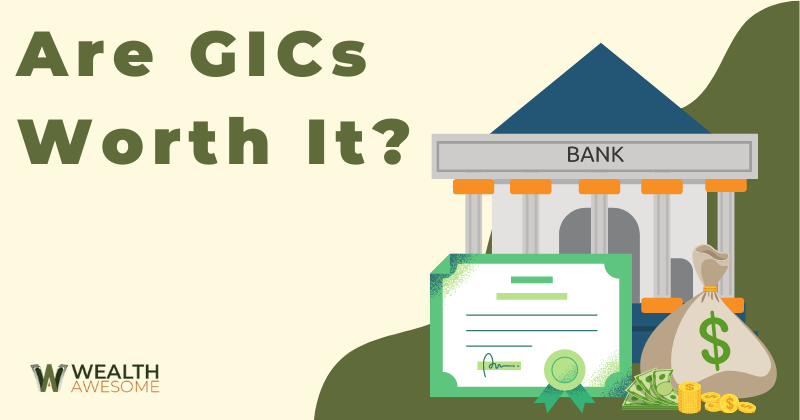It’s important for Canadians to invest their savings in order to be able to keep up with inflation.
We’re starting to see higher interest rates in Canada, such as the 5.35% EQ Bank 1-year GIC rate.
Guaranteed investment certificates (GICs), also known as term deposits, are starting to become more popular. But, are GICs worth it in Canada?
Although GICs can potentially offer a lower return on your dollar compared to other investments, certain circumstances (such as your risk aversion or investment timeline) may make GICs a worthwhile investment.
What is a GIC (Guaranteed Investment Certificate)?
A GIC is a risk-free investment vehicle many financial institutions offer.
It generally offers higher interest rates than savings accounts but lower rates than mutual funds or other “higher risk” investments.
With GICs, your invested funds are “locked” for a certain period. That is, you cannot withdraw your funds during this period regardless of how much you may need them. Longer-term periods are usually coupled with higher interest rates.
GICs are divided into two categories: redeemable and non-redeemable.
Redeemable GICs: Redeemable GICs usually offer lower interest rates. The investment term may range from one to five years, but your funds are only locked for 30 or 90 days. After this period, you may redeem your funds even if the term hasn’t finished.
Because you have the flexibility to withdraw your funds after this short period, the interest rate is usually lower than non-redeemable GICs.
Non-redeemable GICs: with this type of GIC investment, you cannot access your funds during the entire term. If you have chosen a five-year term, for instance, your funds will be locked away for the entirety of the five years, but your gained interest will also be higher than what it would be for a one-year term.
GICs can both be registered or non-registered. Most banks offer both, but some digital banks may not have registered options.
Escalating and Market-Linked GICs
Now that we have covered the basics of GICs, let’s talk about two special types of GICs that financial institutions may offer.
Escalating GICs: when you enter into an escalating term deposit or GIC, the interest gained on your funds increases each year. For instance, it may be 1% in the first year, 1.5% in the second, and 2.1% in the third.
Escalating GICs may be redeemable or non-redeemable.
Market-Linked GICs: much like regular GICs, market-linked GICs receive a guaranteed amount at the end of the term. Beyond this, however, they can potentially make more interest based on the stock market’s performance.
If the stock market has gone down in the duration of your term, you will only receive your principal back and maybe an additional, small amount of interest that will have been decided at the time of purchase. If the stock market goes up, you will make more interest.
This type of GIC is the only one that involves some type of speculation regarding the market’s future performance and can be viewed as a type of “hybrid” investment.
Are GICs Worth It?
The truth is that other investments, such as stocks, ETFs, or real estate, have significantly higher return potential on your dollar.
But it is not as black and white as that.
All of the above types of investments come with investment risk.
As such, GICs may be worth it in certain circumstances, such as:
- Diversifying your investment portfolio
- Avoiding the risk that is associated with speculative investments
- Having a “fixed income” on some of your investments (i.e. guaranteed, annual interest income)
- Earning better interest in comparison to savings accounts (i.e. if you were going to have your money in a savings account anyway, you might as well put it in a redeemable GIC, at the least)
- You only have a short investment horizon (i.e. want access to the funds in one, two, or three years’ time)
- You tend to spend your savings and believe that the non-redeemable nature of a GIC will help you save
GICs are also protected by the Canadian Deposit Insurance Corporation (CDIC) and have no administration fees.
Are Market-Linked GICs Worth It?
Market-linked GICs are a hybrid type of investment that could offer significantly higher gains than regular GICs as long as the stock market goes up.
The good thing with this type of investment is that you will get 100% of your principal back even if the stock market goes down.
Despite this advantage, I wouldn’t say that market-linked GICs are worth it. If you are willing to take the “risk” that is associated with the market, I would recommend that you go with regular stocks or mutual funds, specifically because market-linked GICs are not very tax efficient.
Stock investing comes with good tax advantages that you must forgo if you choose a market-linked GIC. As such, I would either recommend a regular GIC or regular stock investing.
You may still be able to make good returns with a market-linked GIC if the market goes up by a good amount, specifically if you place it in a registered account and take advantage of federal tax perks. Just be sure to get some expert (and non-biased) advice beforehand!
Disadvantages of GICs
There are some disadvantages associated with GICs, particularly:
- Interest is usually lower than other, riskier investments and may not even beat the rate of inflation
- Your money is tied up for a specific amount
- The interest you make is taxed more than returns on stock investments (unless it is in a registered account)
A GIC’s disadvantage increases if the stock market is doing well as you are giving up good returns in exchange for security.
All in all, the decision is up to you.
GIC vs. Savings Account

GIC and savings accounts are different by nature. A GIC account is an investment vehicle that usually pays a better interest than its savings account counterpart.
In short, go with a high-interest savings account if you need easy and regular access to your funds and a GIC account if you are okay with locking up your funds for some time.
That is to say, savings accounts are better for short-term goals, and GICs are better for medium-term goals.
Beware that some big banks offer lower rates on their GICs than some digital banks do on their high-interest savings accounts. If you are looking for a good interest rate on your savings account, I recommend EQ Bank.
EQ Bank also offers good GIC rates, such as the 5.35% EQ Bank 1-year GIC rate.
Can You Lose Money With a GIC?
No, you cannot lose money with a GIC. You are guaranteed to get your entire principal back plus the interest that you agreed upon when you bought the GIC.
You cannot lose money even on a market-linked GIC, in which you are guaranteed to get at least your principal back.
What you can lose with a GIC, however, is value.
Most GICs pay very low interest, which often does not cover the average annual inflation per year in Canada. This means that even if you invest in a GIC, you would not be able to buy the same basket of goods the following year with the same nominal amount.
If you are okay with the risk, I recommend going with stocks to beat inflation.
Why Do Banks Offer GICs?

Much like any other type of business, banks need access to capital. This may be to sell loans or mortgages, develop their business or other business activities.
GICs are a way to get an influx of capital into the bank’s assets under administration.
If you buy into a five-year term, for example, it is guaranteed that that money will be with the bank for the entirety of the five years, which is beneficial for the bank.
This is why a five-year term pays more interest than a one year; it offers consumers an incentive to “lock-in” for longer.
If a bank is desperate for cash, it will simply increase its GIC rates. This will prompt more people to buy GICs, and by the time the terms are finished, they will have (hopefully) made the interest they have to pay their customers plus a profit.
Regardless of a bank’s cash status, GIC rates are determined based on the prime rate.
Conclusion

GICs are a no-risk and relatively low-return investment vehicle offered by most financial institutions in Canada.
However, their relatively short horizon and low-risk characteristics may make them an attractive option to many people. This is especially the case if you are choosing between a savings account or a GIC.
If you are okay with the risk, however, I would recommend other investment vehicles instead.
You can read up on different investment strategies here on Wealth Awesome. To start, check out this post on how to buy stocks in Canada or the best crypto stocks in Canada.





